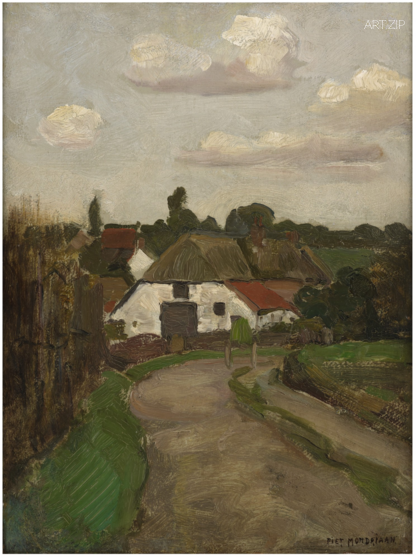
26 November 2015 – 23 Janurary 2016
David Zwirner is pleased to present an exhibition of early paintings by Dutch painter Piet Mondrian (1872-1944) at the gallery’s London location. Curated by Karsten Schubert, the exhibition will provide a concise view of the artist’s gurative landscape paintings from 1900-1905, highlighting the period prior to his involvement with De Stijl and Neo-Plasticism, for which he is most known. The selection of works, which depict the Dutch countryside outside of Amsterdam, reflect Mondrian’s lifelong interest in nature and represent some of the earliest examples in his evolution toward increasingly geometric abstractions. This is the rst exhibition ever to focus on this particular period of Mondrian’s oeuvre, and the rst presentation of the artist’s work at the gallery.
The dense, small-scale paintings included in this exhibition mark a highly proli c period in Mondrian’s engagement with gurative landscape painting—an early but deeply signi cant stage in the artist’s methodical progression from naturalistic representation to complete grid-based abstraction. Prior to moving to Paris in 1911 at age 39, Mondrian spent the early part of his life in his native country of the Netherlands, where he attended the National Academy of Fine Arts in Amsterdam from 1892 to 1897. While landscape painting was discouraged at the Academy in favor of still lifes or gure studies, Mondrian spent much of his free time exploring and sketching the countryside around Amsterdam, focusing in particular on trees, canals, irrigation ditches, and farm buildings, which he rendered on paper and canvas with dynamic realism. As he remarked later in his career, “Nature (or what I see) inspires me, gives me, as it gives all painters, the emotion which brings forth creative élan, but I am seeking to approach truth as closely as possible, and to abstract everything from it until I reach the foundations (always visible foundations!) of things. That for me is truth…”1 His paintings, which were executed both en plein air and in the studio, employ thick pigmented strokes applied with great virtuosity, revealing a style that is at once free and highly constructed.
Part of a group of paintings that Mondrian produced depicting country barns and houses, A Farmhouse Behind a Fence (ca. 1904) is characterised by the loose rhythm of verticals and horizontals of a wooden fence, behind which a farmhouse articulated in at planes dominates the background. Mondrian later maintained that this and similar works were examples of his evolution to abstraction, remarking, “Was it by chance that [the founders of Neo-Plasticism] found such an appropriate subject through which to express their feeling for determinate relationships in an unforshortened (nonperspectival) view of a farmhouse, with its mathematical articulation of planes (large doors and groupings of windows) and its primary (basic) colours?”2 As explored in this exhibition, Mondrian’s early works embody both the roots of traditional Dutch landscape painting, characterized by naturalistic observation, and the foundations of his later grid-based compositions that exemplified his radical contributions to Neo-Plasticism and the De Stijl movement.
1 Mondrian, letter to art teacher H.P. Bremmer, dated 1914, quoted in Hans Janssen and Joop M. Joosten, eds., Mondrian, 1892-1914: The Path to Abstraction (Zwolle, the Netherlands; Fort Worth, Texas; and Paris: Waanders Publishers; Kimbell Art Museum; and Réunion des musées nationaux, 2002), p. 16.
2 Mondrian, “Het Bepaalde en het Onbepaalde,” originally published in De Nieuwe Beelding in de schilderkunst 2 (1918-19), quoted in ibid., p. 90.


